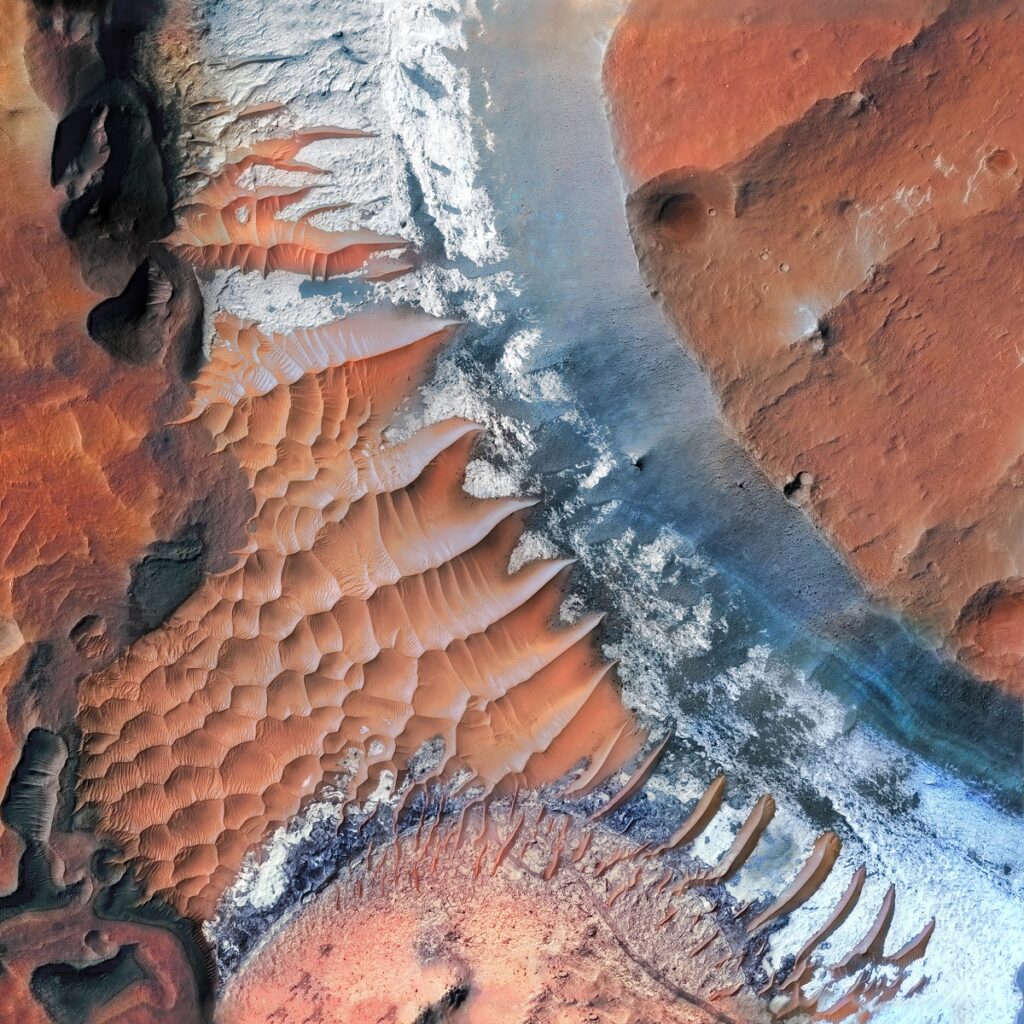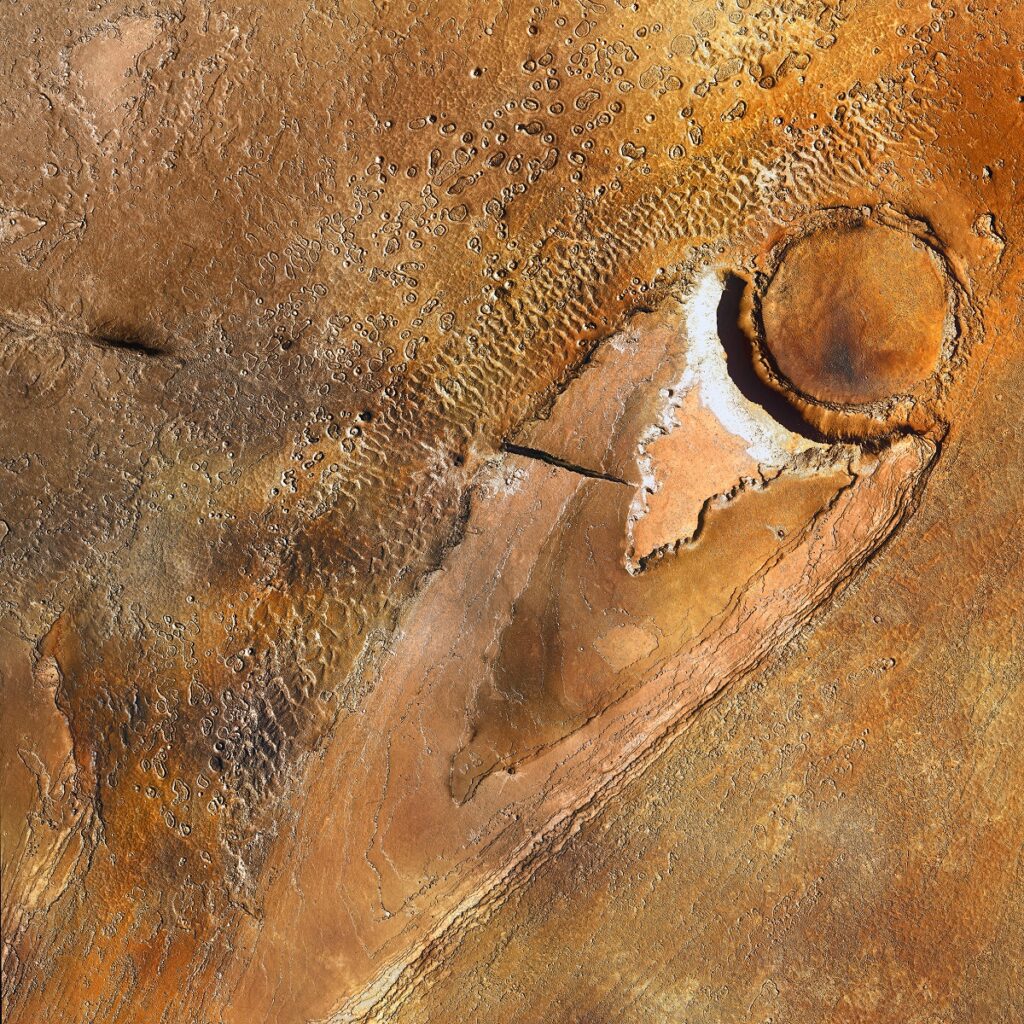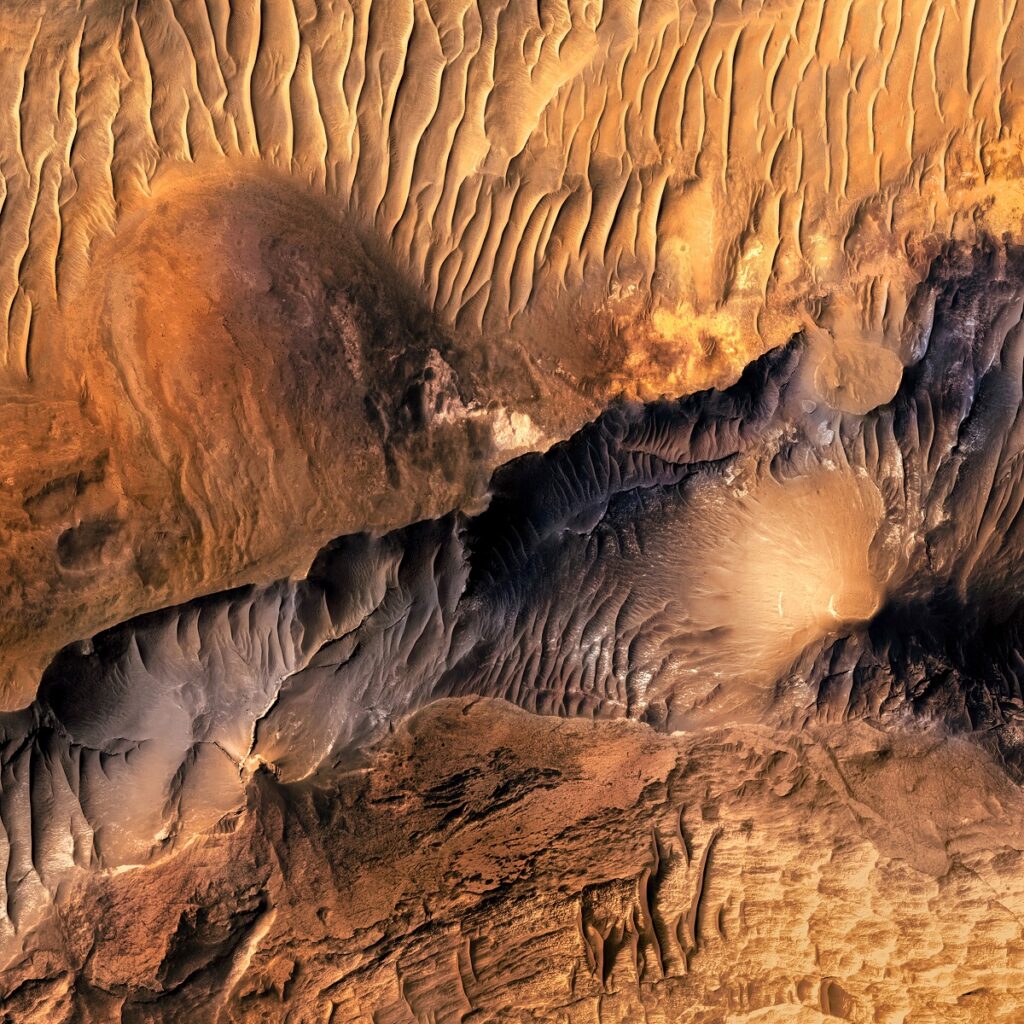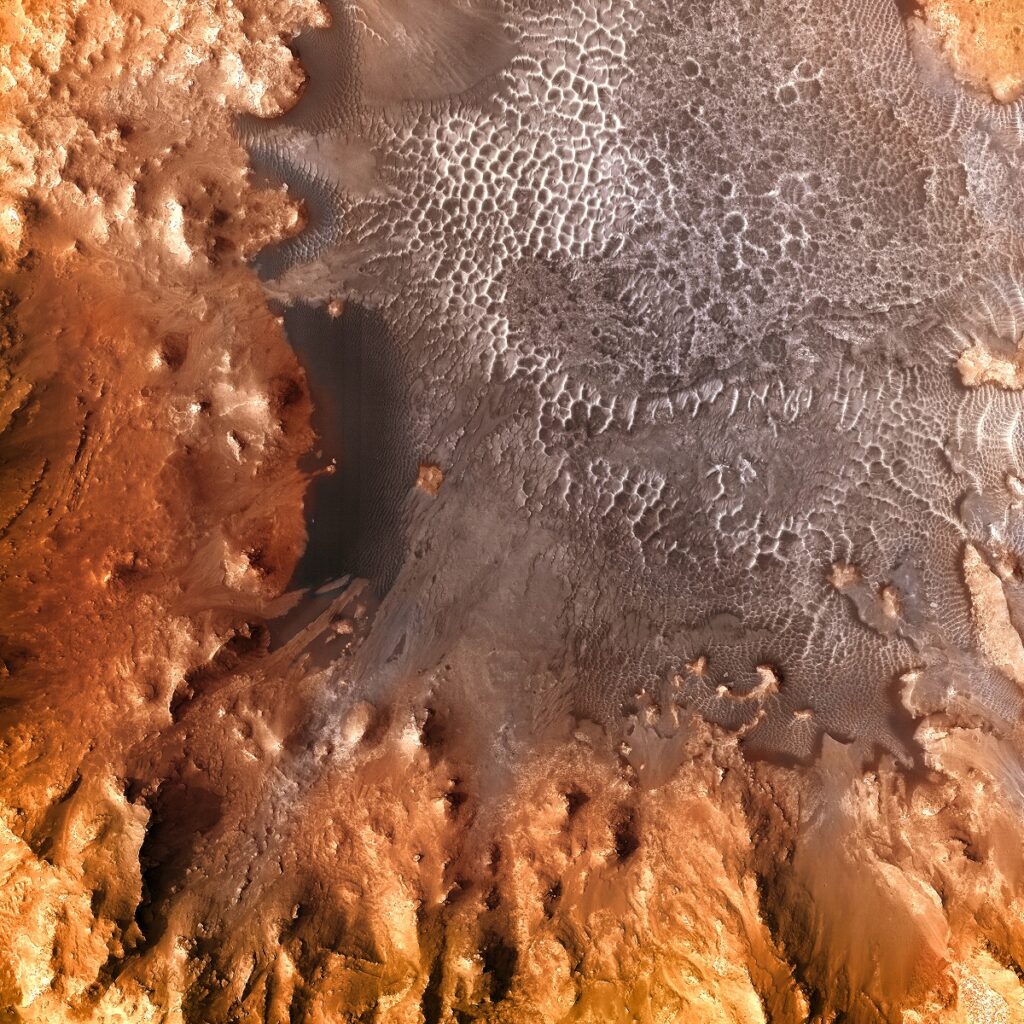Top 10 Facts About Mars
Top 10 Facts About Mars
WhiteClouds Builds 3D Marscapes and Canvas Prints
Did you know we make
custom
8K Mars Canvas Prints
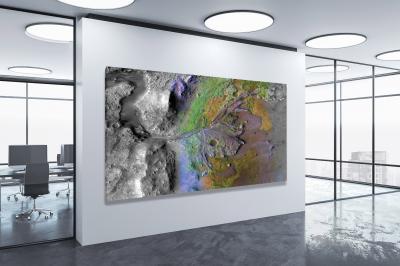
and
3D Marscapes
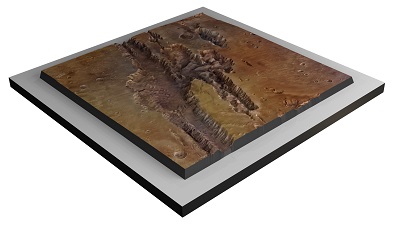
Prepare to embark on an interplanetary voyage unlike any other! Mars, the dazzling ruby jewel of our solar system, has fascinated humans for millennia. Today, we have the privilege of diving into the top 10 mind-blowing facts about Mars that will leave you absolutely spellbound. Fasten your seat belts, cosmic explorers; this will be a ride to remember!
#1: Towering Titan: Olympus Mons
Pack your mental bags because our first stop is nothing short of cosmic splendor—Olympus Mons, the towering titan of volcanoes that not only dominates Mars but also holds the unparalleled title of the largest volcano in the solar system. Let’s attempt to grasp its dizzying grandeur. Imagine a gargantuan mountain that dwarfs Earth’s Mount Everest by not double, but triple its height. We’re talking about a volcanic titan that soars an astonishing 13.6 miles into the Martian sky. To give you perspective, commercial airplanes fly at altitudes of about 6 to 7 miles. Olympus Mons is so tall, it nearly punctures the Martian atmosphere!
But its elevation is just the tip of the, well, volcano. Olympus Mons is a behemoth in diameter as well, stretching across an awe-inspiring 370 miles. For context, that’s approximately equivalent to the size of the entire state of Arizona! Imagine standing at the base of this monolithic structure; you’d likely be unable to see the other side. It’s a vast, sprawling plateau, ringed with steep cliffs that reach up to 8 miles high—a fortress of natural wonder that dwarfs any earthly mountain or volcano. How’s that for challenging your sense of scale? Truly, Olympus Mons stands as one of the most staggering geographic features in our solar system, a monument to the potent forces that have sculpted Mars over billions of years.
#2: The Martian Grand Canyon: Valles Marineris
Now, hold your breath and tighten your seatbelts because if Olympus Mons left you awestruck, Mars has another geographical ace up its sleeve—Valles Marineris. This is a canyon so mammoth in scale that calling it the “Martian Grand Canyon” almost feels like an understatement. Imagine a chasm so vast and deep that it could span the entire continental United States from New York to San Francisco. We’re talking about a rift that’s so colossal, it makes Earth’s Grand Canyon appear like a mere scratch on the surface.
Valles Marineris is not just a gorge; it’s a network of interconnected canyons, stretching an almost incomprehensible 2,500 miles across the Martian equator. At some points, this awe-inspiring abyss plunges 7 miles deep—more than five times the depth of Earth’s deepest ocean trench, the Mariana Trench. The canyon was not formed by water erosion as our own Grand Canyon was but is thought to be the result of ancient tectonic and volcanic activity. These primordial forces tore open the Martian crust, creating a geological masterpiece that stands as one of the most magnificent canyon systems known to science.
Carved and sculpted by ancient processes that we’re still striving to understand, Valles Marineris serves as a monumental testament to Mars’s tumultuous past—a vivid scar etched across the face of our celestial neighbor. Every fissure, every cliff, and every rocky outcrop tells a story millions, if not billions, of years in the making. It’s a natural wonder that challenges our comprehension, leaving us to marvel at the untamed forces that shape the worlds beyond our own.
#3: Red Planet, Blue Sunset: A Mesmerizing Cosmic Ballet of Light and Color
There’s a saying that captures the strange allure of Martian landscapes—”Mars is red, and its sunsets are blue.” This isn’t just poetic license, but a marvelous scientific phenomenon brought to life by the particular composition of the Martian atmosphere. On Earth, sunsets often paint the sky with a warm, orange-red palette, thanks to the scattering of sunlight by our planet’s atmosphere. On Mars, however, the atmosphere performs a unique light-scattering trick, offering a surreal spectacle that turns our earthly expectations on their heads.
The Martian atmosphere, much thinner than Earth’s and composed primarily of carbon dioxide, bends and scatters the sunlight in such a way that the skies burst into an ethereal blue glow as the sun prepares to bow out for the day. Imagine standing on the Martian surface, surrounded by reddish, barren terrain and watching as a dreamlike azure light softly embraces the horizon, casting otherworldly shadows on the desolate landscape. Your eyes wouldn’t believe the scene—a vivid, almost ghostly, blue twilight slowly engulfing the world around you. It’s an experience that defies earthly comparison, like gazing into an inverted universe where familiar rules of color and light no longer apply.
#4: A World of Two Faces: The Geographical Dichotomy That Defines the Red Planet
Mars is nothing short of a planetary enigma, a cosmic Janus with two entirely distinct faces that paint a picture of a world both young and ancient, calm and chaotic. As you travel across its equator, you’ll encounter a perplexing dichotomy that has puzzled scientists for years. On one hand, the northern hemisphere presents itself as a vast, almost serenely smooth plain, one that hints at the possibility of oceans and seas that have long since evaporated and disappeared into the thin Martian air. These expansive lowlands beckon with the promise of secrets concealed deep within their soils—perhaps evidence of ancient life or a watery history that may have once nurtured simple organisms.
In stark contrast, the southern hemisphere offers a dramatically different portrait. It’s a rugged, untamed land strewn with craters and scarred by millennia of meteoric impacts and geological tumult. The terrain here is pocked and battered, like the face of a battle-hardened warrior. Each crater, gorge, and mountain range stands as a monument to the Red Planet’s turbulent past—a vivid tableau of cosmic upheaval and planetary evolution. Researchers believe this dramatic geographical split may be the result of a colossal impact or tectonic forces that ripped through the planet ages ago, shaping its dual personality.
#5: The Martian Mysteries Unveiled: The Enigmatic Moons Phobos and Deimos
One of the most beguiling aspects of Mars is its duo of irregularly shaped moons—Phobos and Deimos. Unlike our moon, which is relatively spherical, these moons resemble misshapen potatoes, their surfaces marred by craters and grooves. Originating most likely from the asteroid belt between Mars and Jupiter, these celestial bodies were captured by the Red Planet’s gravitational pull and have since become subjects of intense scientific scrutiny and public fascination.
Phobos, the larger and closer of the two moons, is particularly intriguing. It orbits so close to Mars that it’s gradually spiraling inward, losing altitude with each circuit around the planet. Current orbital calculations suggest that Phobos is on a collision course with destiny—it may either crash spectacularly into Mars or disintegrate under tidal forces to form a ring encircling the planet. Either scenario would be a celestial event of unprecedented magnitude, offering a treasure trove of scientific data and an awe-inspiring display of cosmic theatrics. But beyond its ultimate fate, Phobos also presents interesting questions about planetary formation and moon-planet interactions, making it an object of continued scientific inquiry.
Deimos, though smaller and further away, is no less fascinating. Its surface, like that of Phobos, is pitted with craters and scars, suggesting a history fraught with impacts and close encounters with other celestial objects. Both moons serve as cosmic time capsules, containing within their twisted forms clues about the early solar system, Mars’ gravitational pull, and even the conditions required for life as we know it. Together, Phobos and Deimos stand as silent guardians of Mars, complex and enigmatic bodies that remind us of the captivating lore and boundless mysteries that the Red Planet offers.
#6: A Whispering Wind: The Atmospheric Ballet of Martian Breezes
Mars may lack the thick, breathable atmosphere of Earth, but it’s not entirely devoid of weather patterns. The Red Planet has an atmosphere, albeit a thin one, primarily composed of carbon dioxide. Within this tenuous gaseous envelope, winds whip across the barren landscape, lifting the Martian dust into the air and sculpting it into devilish dust devils and wispy whirlwinds. It’s a ballet of particles and air currents, orchestrated by the planet’s own geophysical peculiarities.
Imagine standing on the Martian surface, in a protective suit of course, looking out over the endless red plains. As you gaze across this alien landscape, you’d hear the soft, eerie whispers of the Martian wind, howling gently through the valleys and across the plains. These are not merely the sounds of emptiness; they are the murmurs of a planet alive with geological and atmospheric activity. It’s a symphony of wind and dust that dances across the surface, continually reshaping it in tiny but significant ways.
The Martian winds are not just a fascinating atmospheric phenomenon; they also contribute to the planet’s ever-changing topography. These winds have the power to move sand dunes, carve rock, and erode landscapes over time. They also play a role in the redistribution of heat across the planet’s surface. It’s a gentle yet ever-present reminder of the planet’s inherent dynamism, a world that, although seemingly frozen in time, is very much alive in its own unique way.
#7: Frozen Wonders: The Enigmatic Martian Ice Caps
Believe it or not, Mars, a planet often associated with arid deserts and scorching temperatures, is also home to polar ice caps. These frozen citadels are composed of a mixture of water and dry ice (frozen carbon dioxide) and serve as one of the most visible landmarks on the Martian surface. The ice caps wax and wane with the Martian seasons, growing and shrinking in response to the planet’s axial tilt and orbit around the sun.
Some scientists go so far as to postulate that these ice caps could be a veritable treasure trove of information regarding Mars’ climatic history. Layers of ice, like the rings of a tree, could potentially reveal millions of years of Martian seasons, atmospheric conditions, and even traces of ancient microbial life. Researchers are particularly interested in studying the ratio of water to dry ice within the caps, as this could offer invaluable insights into the planet’s hydrological cycle and its potential to support life, either in the past or even in the future.
But beyond their scientific significance, these icy landmarks serve as a poetic contrast to the hot, dry, reddish expanses that dominate much of the Martian surface. They’re frozen oases in a desert of fire, tantalizing with the promise of water in a world where liquid H2O is extraordinarily rare. As we continue to study and explore this fascinating planet, the ice caps stand as both a scientific enigma and a symbol of the endless complexities and contradictions that make Mars one of the most intriguing bodies in our solar system.
#8: The Quest for Life and the Enigma of Methane: Unfurling Mars’ Biggest Mysteries
Contrary to what its barren landscapes might suggest, Mars is not as devoid of activity as it appears. Among the most tantalizing pieces of evidence that suggest Mars could harbor more secrets than meets the eye is the periodic detection of methane in its thin atmosphere. Methane, a molecule that on Earth is often associated with biological processes, has been detected in varying concentrations at different times and places on the Red Planet. These detections immediately raise riveting questions: What is the source of this methane? Is it a result of geological activity like subsurface chemical reactions or volcanic outgassing? Or could it potentially be a byproduct of some form of microbial life lurking below the surface?
The quest to resolve these questions is a major focal point for both current and upcoming missions to Mars, including robotic landers, rovers, and orbiting satellites equipped with state-of-the-art scientific instruments. Researchers are scrutinizing data to find patterns in methane emissions, studying how these concentrations change with the Martian seasons, and even considering the implications of these emissions on the planet’s past, present, and future. The methane mystery is one of the linchpins of astrobiology and planetary science, serving as a tantalizing clue in our search for extraterrestrial life and understanding the conditions required for life to exist.
#9: Traces of a Watery Past: Mars’ Ancient Riverbeds and Forgotten Lakes
The present-day Martian landscape may be a desolate expanse of dust and rocks, but it wasn’t always this way. Indeed, the surface of Mars is replete with geological features that serve as compelling evidence that Mars was once a wet world, perhaps not too different from early Earth. Among these are ancient river valleys, now dried-up but still visible as winding grooves etched into the Martian terrain. Additionally, the presence of sedimentary rocks, layered in a manner that usually requires the action of water, further hints at a once-aqueous environment.
Visualize, if you will, a Martian past where rivers meandered gracefully through lush valleys, perhaps feeding into expansive lakes or even shallow seas. Imagine these bodies of water, rich in minerals, possibly nourishing primeval life forms, from simple microbes to more complex organisms. What a mesmerizing sight that would’ve been, a stark contrast to the arid vistas we associate with Mars today! The relics of these ancient riverbeds and lake beds offer scientists a rich tapestry to study, serving as both a window into Mars’ more hospitable past and a base upon which hypotheses about Martian life—past or potential future—can be built.
#10: The Horizon of Human Destiny: Mars as the Next Frontier of Exploration and Settlement
Mars is not just an object of scientific inquiry; it’s a beacon that draws the human spirit towards the unimaginable possibilities of exploration, discovery, and even colonization. Through programs like NASA’s Artemis, ambitious plans are already in motion to put the first woman and the next man on the Martian surface sometime in the 2030s. This is not just another space mission; it’s a seminal moment for humanity, a chance to step onto another world and extend our presence beyond the Earth-Moon system.
Imagine a future where Mars becomes humanity’s second home, a place where we’re not just visitors but residents. Picture habitats constructed from Martian materials, greenhouses where we grow our own food, and laboratories where scientists work to unlock the Red Planet’s countless secrets. The exhilarating prospects range from mining valuable minerals to studying Mars’ geological and climatic changes for insights that could benefit Earth, to the monumental—a self-sustaining human civilization on another planet.
The dream of making footprints on Martian soil, once the stuff of science fiction, is becoming increasingly feasible. As we stand on the cusp of this new era, the vision of Mars as the next frontier isn’t just an idea; it’s a palpable, thrilling future full of endless possibilities. Mars beckons, and it seems it won’t be long before we answer its call.
Mars is not just a dot of red in the night sky; it’s a dynamic, complex world teeming with mysteries begging to be explored. With its towering volcanoes, monumental canyons, and tantalizing hints at life, Mars challenges us to expand our horizons and dream beyond the limits of Earth. So keep your eyes on the stars, and you might just catch a glimpse of Mars winking back at you—a cosmic invitation to explore the unknown.
Keep dreaming, keep exploring, and perhaps one day, the red soil of Mars will be imprinted with the boot of a human, marking the ultimate journey into the great cosmic beyond!
Check out our 3D Mars Learning Center for more information on Mars and its tallest mountains. You can also learn more at: NASA Mars Exploration.
More About Mars
Contact us today to learn more about our 3D services and how we can help you achieve your goals.
